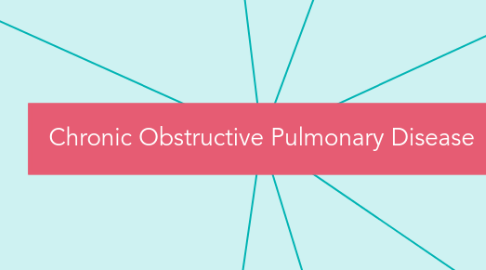
1. Production of sputum
2. Breakdown of connective tissue.
2.1. Destruction of alveolar walls, septae and capillaries
2.1.1. Impaired gas diffusion
2.1.2. Loss of elastic recoil
2.1.2.1. Bullae develops
2.1.3. Loss of alveolar attachments
2.1.3.1. Air trapping occurs during expiration
3. Bronchoconstriction
4. Hypoventilation
4.1. Hypoxemia
4.2. Hypercapnia
5. Pathogenesis
5.1. Emphysema
5.1.1. Alpha-1-antitrypsin deficiency
5.1.1.1. Breakdown of elastin fibers
5.1.2. Inflammation
5.1.2.1. Recruitment of neutrophils to bronchioles and alveoli
5.1.2.1.1. Proteolytic enzymes and elastase enzymes are released
5.2. Chronic bronchitis
5.2.1. Exposure to irritants cause inflammation in airways
5.2.1.1. Inflammation
5.2.1.1.1. Increase in oxidative stress, inflammatory mediators and cytokines
5.2.1.1.2. Enlargement of submucosal glands
5.2.1.1.3. Leukocytes and lymphocytes infiltrate bronchioles
6. Diagnostics
6.1. Pulmonary function test
6.1.1. Spirometry
6.1.1.1. Evaluates airway obstruction
6.2. Forced vital capacity, forced expiratory volume, forced expiratory flow, residual volume, functional residual capacity
6.2.1. Indicates air trapping and airway obstructiom
6.3. Chest x-ray/chest CT scan
6.4. Arterial blood gas test
6.4.1. Determine severity of COPD
6.4.2. Measure oxygenation and gas exchange
6.5. Health history
6.6. Physical examination
6.7. Screening for alpha-1-antitrypsin levels
6.7.1. An enzyme that protects lung parenchyma
6.7.2. Performed at 45 years of age or younger
6.8. Oximetry
6.8.1. Determine adequate oxygenation
6.9. Sputum and culture sensitivity
6.9.1. Tests for Streptococcus pneumoniae and Haemophilus influenzae.
6.9.2. Identifies pathogens
6.10. Bronchogram
6.11. ECG test
6.12. ECG stress test
7. Treatments
7.1. Change lifestyle
7.1.1. Quit smoking
7.1.2. Avoid lung irritants
7.1.2.1. Second hand smoke
7.1.2.2. Dust
7.1.2.3. Fumes
7.1.2.4. Toxic chemicals
7.1.3. Eat meals that meet nutritional needs and take vitamins
7.2. Pharmacological
7.2.1. Bronchodilators
7.2.1.1. Relax muscles around airways
7.2.1.2. Take with glucocorticosteroids
7.2.1.2.1. Reduces inflammation in airway
7.2.2. Antibiotics
7.2.2.1. Help with respiratory infection
7.2.2.1.1. Amoxicillin
7.2.2.1.2. Doxycycline
7.2.2.1.3. Azithromycin
7.2.2.1.4. Erythromycin
7.2.3. Cough suppressants
7.2.4. Xanthines
7.2.4.1. Reduce mucosal edema and spasms
7.3. Vaccinations
7.3.1. Flu shot
7.3.2. Pneumococcal vaccine
7.4. Pulmonary rehabilitation
7.5. Oxygen therapy
7.5.1. Increase levels of O2 in blood
7.5.2. Improves breathing
7.5.3. Protects internal organs
7.6. Surgery
7.6.1. Bullectomy
7.6.1.1. Removing large air spaces in lungs will improve breathing
7.6.2. Lung Volume Reduction
7.6.2.1. Removing damaged lung tissue
7.6.3. Lung transplant
8. Risk Factors
8.1. Genetics
8.1.1. Alpha-1-antitrypsin deficiency
8.1.1.1. Increase risk for lung and liver disease
8.2. Age
8.2.1. Occurs in people at least 40 years of age or older
8.3. Environmental
8.3.1. Occupations involved in with dust and chemicals
8.3.2. Exposure to fumes
8.3.2.1. Poor ventilated homes
8.4. Smoking
8.4.1. Exposure to tobacco smoke
8.4.1.1. Pipe smokers
8.4.1.2. Cigar smokers
8.4.1.3. Marijuana smokers
8.4.2. People with asthma who smoke
9. Clinical Manifestations
9.1. Wheezing
9.2. Dyspnea
9.2.1. Cyanosis of lips and fingernail beds
9.2.2. Clubbing of fingernails
9.3. Chest tightness
9.4. Ongoing cough
9.4.1. With sputum
9.4.1.1. Grey
9.4.1.2. Yellow
9.4.1.3. White
9.5. Fever
9.6. Edema in ankles, feet, or legs
9.7. Colds or other respiratory infections
9.7.1. Flu
9.8. Lower muscle endurance or lack of energy
9.9. Weight loss
9.10. Barrel chest
10. Incidence/Prevalence
10.1. 3rd leading cause of death in the world
10.2. About 64 million people around the world have COPD
10.2.1. About 3 million deaths
10.2.1.1. About 90% occur in low and middle income countries
10.3. 12.7-14.7 million adults have COPD in U.S.
10.3.1. 120,000 deaths in U.S. per year
10.4. Highest incidence
10.4.1. Older adults
10.4.1.1. Occurs more often in females than males
10.4.2. People who smoke
10.4.2.1. About 80% of all COPD deaths
